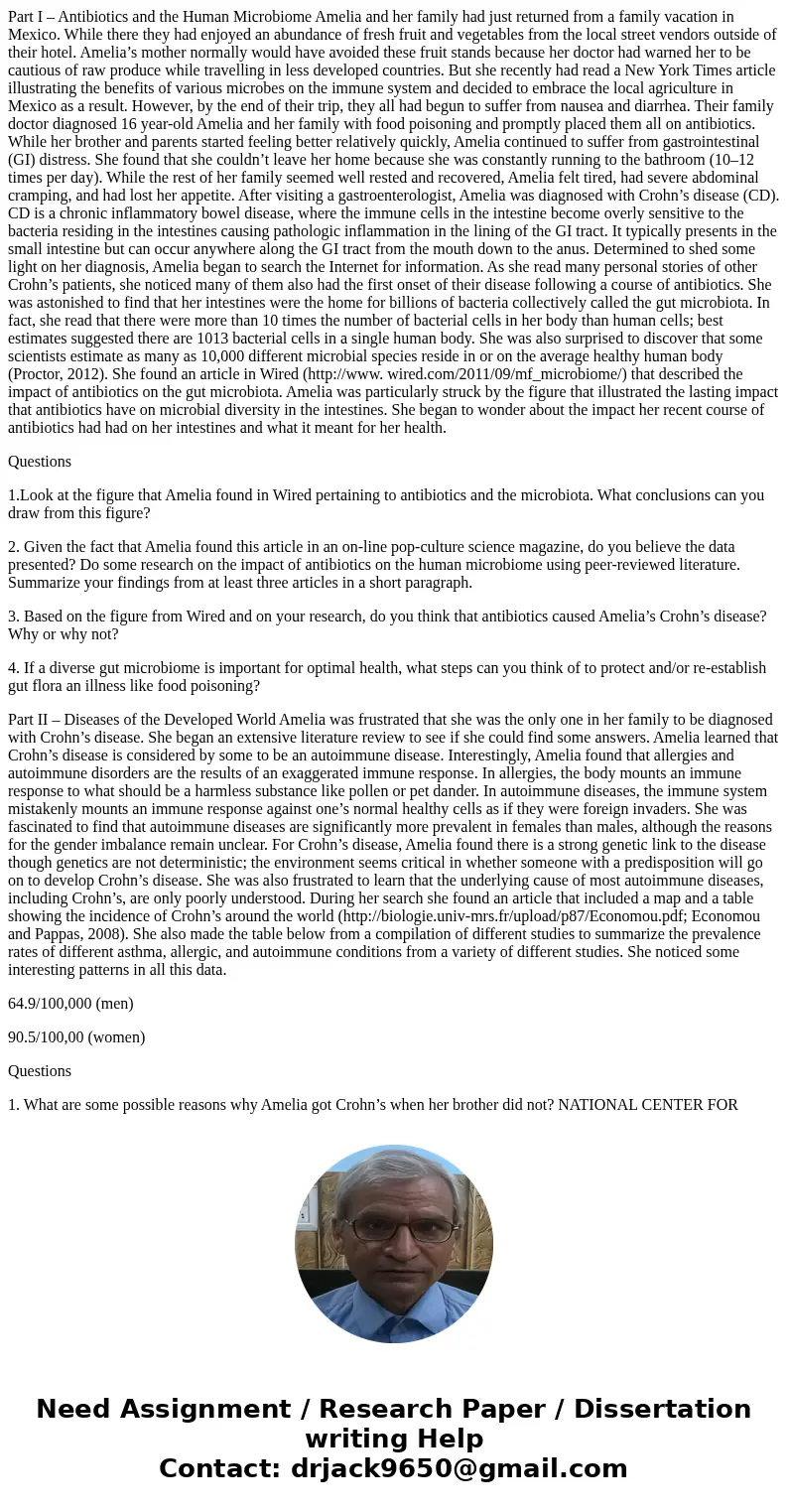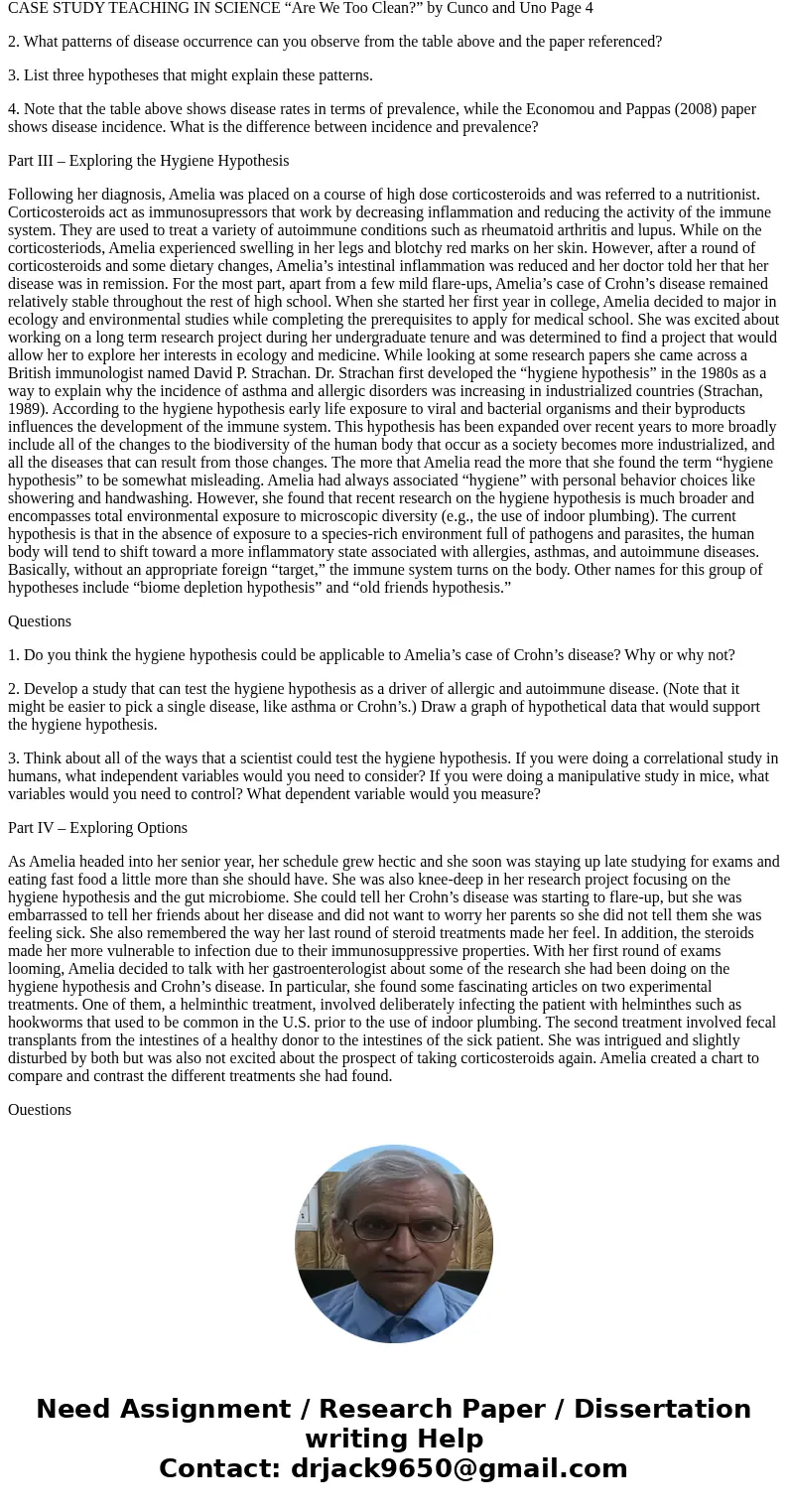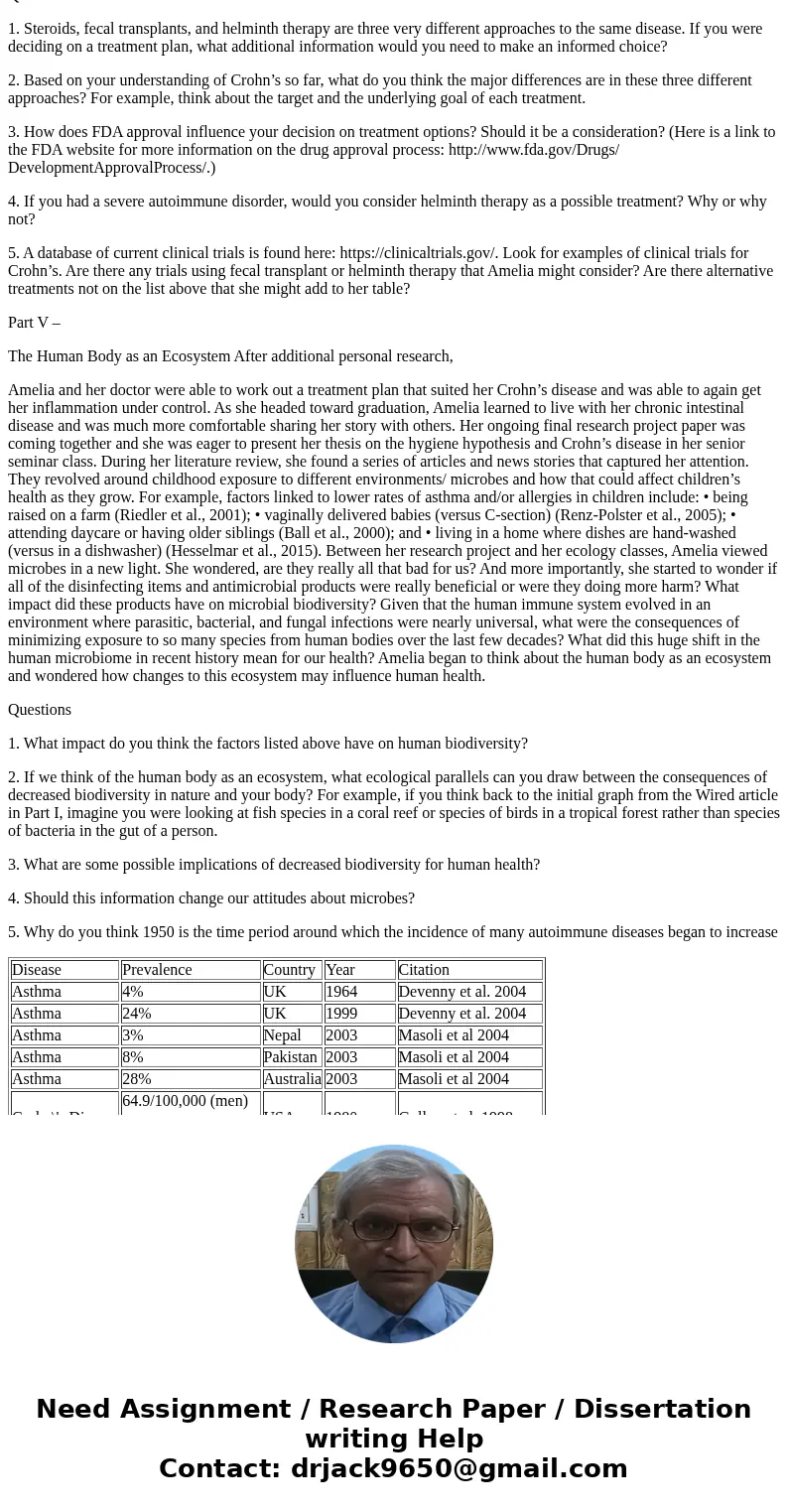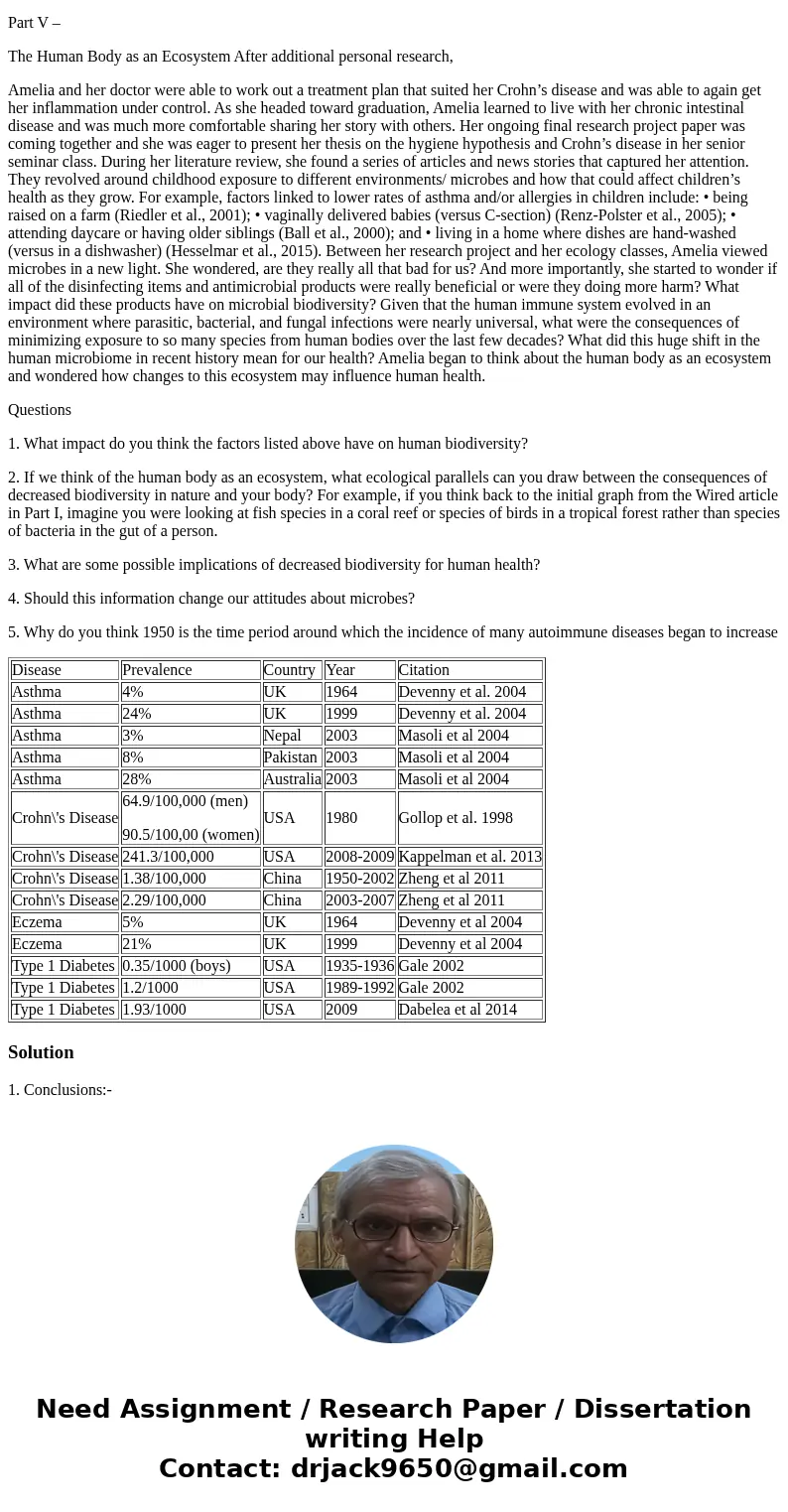Part I Antibiotics and the Human Microbiome Amelia and her
Part I – Antibiotics and the Human Microbiome Amelia and her family had just returned from a family vacation in Mexico. While there they had enjoyed an abundance of fresh fruit and vegetables from the local street vendors outside of their hotel. Amelia’s mother normally would have avoided these fruit stands because her doctor had warned her to be cautious of raw produce while travelling in less developed countries. But she recently had read a New York Times article illustrating the benefits of various microbes on the immune system and decided to embrace the local agriculture in Mexico as a result. However, by the end of their trip, they all had begun to suffer from nausea and diarrhea. Their family doctor diagnosed 16 year-old Amelia and her family with food poisoning and promptly placed them all on antibiotics. While her brother and parents started feeling better relatively quickly, Amelia continued to suffer from gastrointestinal (GI) distress. She found that she couldn’t leave her home because she was constantly running to the bathroom (10–12 times per day). While the rest of her family seemed well rested and recovered, Amelia felt tired, had severe abdominal cramping, and had lost her appetite. After visiting a gastroenterologist, Amelia was diagnosed with Crohn’s disease (CD). CD is a chronic inflammatory bowel disease, where the immune cells in the intestine become overly sensitive to the bacteria residing in the intestines causing pathologic inflammation in the lining of the GI tract. It typically presents in the small intestine but can occur anywhere along the GI tract from the mouth down to the anus. Determined to shed some light on her diagnosis, Amelia began to search the Internet for information. As she read many personal stories of other Crohn’s patients, she noticed many of them also had the first onset of their disease following a course of antibiotics. She was astonished to find that her intestines were the home for billions of bacteria collectively called the gut microbiota. In fact, she read that there were more than 10 times the number of bacterial cells in her body than human cells; best estimates suggested there are 1013 bacterial cells in a single human body. She was also surprised to discover that some scientists estimate as many as 10,000 different microbial species reside in or on the average healthy human body (Proctor, 2012). She found an article in Wired (http://www. wired.com/2011/09/mf_microbiome/) that described the impact of antibiotics on the gut microbiota. Amelia was particularly struck by the figure that illustrated the lasting impact that antibiotics have on microbial diversity in the intestines. She began to wonder about the impact her recent course of antibiotics had had on her intestines and what it meant for her health.
Questions
1.Look at the figure that Amelia found in Wired pertaining to antibiotics and the microbiota. What conclusions can you draw from this figure?
2. Given the fact that Amelia found this article in an on-line pop-culture science magazine, do you believe the data presented? Do some research on the impact of antibiotics on the human microbiome using peer-reviewed literature. Summarize your findings from at least three articles in a short paragraph.
3. Based on the figure from Wired and on your research, do you think that antibiotics caused Amelia’s Crohn’s disease? Why or why not?
4. If a diverse gut microbiome is important for optimal health, what steps can you think of to protect and/or re-establish gut flora an illness like food poisoning?
Part II – Diseases of the Developed World Amelia was frustrated that she was the only one in her family to be diagnosed with Crohn’s disease. She began an extensive literature review to see if she could find some answers. Amelia learned that Crohn’s disease is considered by some to be an autoimmune disease. Interestingly, Amelia found that allergies and autoimmune disorders are the results of an exaggerated immune response. In allergies, the body mounts an immune response to what should be a harmless substance like pollen or pet dander. In autoimmune diseases, the immune system mistakenly mounts an immune response against one’s normal healthy cells as if they were foreign invaders. She was fascinated to find that autoimmune diseases are significantly more prevalent in females than males, although the reasons for the gender imbalance remain unclear. For Crohn’s disease, Amelia found there is a strong genetic link to the disease though genetics are not deterministic; the environment seems critical in whether someone with a predisposition will go on to develop Crohn’s disease. She was also frustrated to learn that the underlying cause of most autoimmune diseases, including Crohn’s, are only poorly understood. During her search she found an article that included a map and a table showing the incidence of Crohn’s around the world (http://biologie.univ-mrs.fr/upload/p87/Economou.pdf; Economou and Pappas, 2008). She also made the table below from a compilation of different studies to summarize the prevalence rates of different asthma, allergic, and autoimmune conditions from a variety of different studies. She noticed some interesting patterns in all this data.
64.9/100,000 (men)
90.5/100,00 (women)
Questions
1. What are some possible reasons why Amelia got Crohn’s when her brother did not? NATIONAL CENTER FOR CASE STUDY TEACHING IN SCIENCE “Are We Too Clean?” by Cunco and Uno Page 4
2. What patterns of disease occurrence can you observe from the table above and the paper referenced?
3. List three hypotheses that might explain these patterns.
4. Note that the table above shows disease rates in terms of prevalence, while the Economou and Pappas (2008) paper shows disease incidence. What is the difference between incidence and prevalence?
Part III – Exploring the Hygiene Hypothesis
Following her diagnosis, Amelia was placed on a course of high dose corticosteroids and was referred to a nutritionist. Corticosteroids act as immunosupressors that work by decreasing inflammation and reducing the activity of the immune system. They are used to treat a variety of autoimmune conditions such as rheumatoid arthritis and lupus. While on the corticosteriods, Amelia experienced swelling in her legs and blotchy red marks on her skin. However, after a round of corticosteroids and some dietary changes, Amelia’s intestinal inflammation was reduced and her doctor told her that her disease was in remission. For the most part, apart from a few mild flare-ups, Amelia’s case of Crohn’s disease remained relatively stable throughout the rest of high school. When she started her first year in college, Amelia decided to major in ecology and environmental studies while completing the prerequisites to apply for medical school. She was excited about working on a long term research project during her undergraduate tenure and was determined to find a project that would allow her to explore her interests in ecology and medicine. While looking at some research papers she came across a British immunologist named David P. Strachan. Dr. Strachan first developed the “hygiene hypothesis” in the 1980s as a way to explain why the incidence of asthma and allergic disorders was increasing in industrialized countries (Strachan, 1989). According to the hygiene hypothesis early life exposure to viral and bacterial organisms and their byproducts influences the development of the immune system. This hypothesis has been expanded over recent years to more broadly include all of the changes to the biodiversity of the human body that occur as a society becomes more industrialized, and all the diseases that can result from those changes. The more that Amelia read the more that she found the term “hygiene hypothesis” to be somewhat misleading. Amelia had always associated “hygiene” with personal behavior choices like showering and handwashing. However, she found that recent research on the hygiene hypothesis is much broader and encompasses total environmental exposure to microscopic diversity (e.g., the use of indoor plumbing). The current hypothesis is that in the absence of exposure to a species-rich environment full of pathogens and parasites, the human body will tend to shift toward a more inflammatory state associated with allergies, asthmas, and autoimmune diseases. Basically, without an appropriate foreign “target,” the immune system turns on the body. Other names for this group of hypotheses include “biome depletion hypothesis” and “old friends hypothesis.”
Questions
1. Do you think the hygiene hypothesis could be applicable to Amelia’s case of Crohn’s disease? Why or why not?
2. Develop a study that can test the hygiene hypothesis as a driver of allergic and autoimmune disease. (Note that it might be easier to pick a single disease, like asthma or Crohn’s.) Draw a graph of hypothetical data that would support the hygiene hypothesis.
3. Think about all of the ways that a scientist could test the hygiene hypothesis. If you were doing a correlational study in humans, what independent variables would you need to consider? If you were doing a manipulative study in mice, what variables would you need to control? What dependent variable would you measure?
Part IV – Exploring Options
As Amelia headed into her senior year, her schedule grew hectic and she soon was staying up late studying for exams and eating fast food a little more than she should have. She was also knee-deep in her research project focusing on the hygiene hypothesis and the gut microbiome. She could tell her Crohn’s disease was starting to flare-up, but she was embarrassed to tell her friends about her disease and did not want to worry her parents so she did not tell them she was feeling sick. She also remembered the way her last round of steroid treatments made her feel. In addition, the steroids made her more vulnerable to infection due to their immunosuppressive properties. With her first round of exams looming, Amelia decided to talk with her gastroenterologist about some of the research she had been doing on the hygiene hypothesis and Crohn’s disease. In particular, she found some fascinating articles on two experimental treatments. One of them, a helminthic treatment, involved deliberately infecting the patient with helminthes such as hookworms that used to be common in the U.S. prior to the use of indoor plumbing. The second treatment involved fecal transplants from the intestines of a healthy donor to the intestines of the sick patient. She was intrigued and slightly disturbed by both but was also not excited about the prospect of taking corticosteroids again. Amelia created a chart to compare and contrast the different treatments she had found.
Questions
1. Steroids, fecal transplants, and helminth therapy are three very different approaches to the same disease. If you were deciding on a treatment plan, what additional information would you need to make an informed choice?
2. Based on your understanding of Crohn’s so far, what do you think the major differences are in these three different approaches? For example, think about the target and the underlying goal of each treatment.
3. How does FDA approval influence your decision on treatment options? Should it be a consideration? (Here is a link to the FDA website for more information on the drug approval process: http://www.fda.gov/Drugs/ DevelopmentApprovalProcess/.)
4. If you had a severe autoimmune disorder, would you consider helminth therapy as a possible treatment? Why or why not?
5. A database of current clinical trials is found here: https://clinicaltrials.gov/. Look for examples of clinical trials for Crohn’s. Are there any trials using fecal transplant or helminth therapy that Amelia might consider? Are there alternative treatments not on the list above that she might add to her table?
Part V –
The Human Body as an Ecosystem After additional personal research,
Amelia and her doctor were able to work out a treatment plan that suited her Crohn’s disease and was able to again get her inflammation under control. As she headed toward graduation, Amelia learned to live with her chronic intestinal disease and was much more comfortable sharing her story with others. Her ongoing final research project paper was coming together and she was eager to present her thesis on the hygiene hypothesis and Crohn’s disease in her senior seminar class. During her literature review, she found a series of articles and news stories that captured her attention. They revolved around childhood exposure to different environments/ microbes and how that could affect children’s health as they grow. For example, factors linked to lower rates of asthma and/or allergies in children include: • being raised on a farm (Riedler et al., 2001); • vaginally delivered babies (versus C-section) (Renz-Polster et al., 2005); • attending daycare or having older siblings (Ball et al., 2000); and • living in a home where dishes are hand-washed (versus in a dishwasher) (Hesselmar et al., 2015). Between her research project and her ecology classes, Amelia viewed microbes in a new light. She wondered, are they really all that bad for us? And more importantly, she started to wonder if all of the disinfecting items and antimicrobial products were really beneficial or were they doing more harm? What impact did these products have on microbial biodiversity? Given that the human immune system evolved in an environment where parasitic, bacterial, and fungal infections were nearly universal, what were the consequences of minimizing exposure to so many species from human bodies over the last few decades? What did this huge shift in the human microbiome in recent history mean for our health? Amelia began to think about the human body as an ecosystem and wondered how changes to this ecosystem may influence human health.
Questions
1. What impact do you think the factors listed above have on human biodiversity?
2. If we think of the human body as an ecosystem, what ecological parallels can you draw between the consequences of decreased biodiversity in nature and your body? For example, if you think back to the initial graph from the Wired article in Part I, imagine you were looking at fish species in a coral reef or species of birds in a tropical forest rather than species of bacteria in the gut of a person.
3. What are some possible implications of decreased biodiversity for human health?
4. Should this information change our attitudes about microbes?
5. Why do you think 1950 is the time period around which the incidence of many autoimmune diseases began to increase
| Disease | Prevalence | Country | Year | Citation |
| Asthma | 4% | UK | 1964 | Devenny et al. 2004 |
| Asthma | 24% | UK | 1999 | Devenny et al. 2004 |
| Asthma | 3% | Nepal | 2003 | Masoli et al 2004 |
| Asthma | 8% | Pakistan | 2003 | Masoli et al 2004 |
| Asthma | 28% | Australia | 2003 | Masoli et al 2004 |
| Crohn\'s Disease | 64.9/100,000 (men) 90.5/100,00 (women) | USA | 1980 | Gollop et al. 1998 |
| Crohn\'s Disease | 241.3/100,000 | USA | 2008-2009 | Kappelman et al. 2013 |
| Crohn\'s Disease | 1.38/100,000 | China | 1950-2002 | Zheng et al 2011 |
| Crohn\'s Disease | 2.29/100,000 | China | 2003-2007 | Zheng et al 2011 |
| Eczema | 5% | UK | 1964 | Devenny et al 2004 |
| Eczema | 21% | UK | 1999 | Devenny et al 2004 |
| Type 1 Diabetes | 0.35/1000 (boys) | USA | 1935-1936 | Gale 2002 |
| Type 1 Diabetes | 1.2/1000 | USA | 1989-1992 | Gale 2002 |
| Type 1 Diabetes | 1.93/1000 | USA | 2009 | Dabelea et al 2014 |
Solution
1. Conclusions:-




 Homework Sourse
Homework Sourse